The Pagani Huayra isn’t just another extraordinary hypercar—it’s a wild Italian dream, sculpted over eight painstaking years that kicked off in 2003. Horacio Pagani, fueled by the Zonda’s success, wanted to push the boundaries of automotive tech, so he named his new creation after the ancient Andean wind god Huayra Tata.
Pagani realized the Zonda, with its early ’90s DNA, just couldn’t keep up with fresh hypercar competitors. He and his team got obsessed—building eight scale models and two full-size prototypes—always chasing that perfect blend of beauty and function.
This deep dive into automotive excellence is honestly a bit of a fever dream. It’s about how the Huayra went from a sketch to a legend, with its Mercedes-AMG twin-turbo V12, that bonkers carbo-titanium body, and a design philosophy that’s more “sculpture” than “car.”
And let’s not forget the wind-inspired aerodynamics. Or the fact that, thanks to its limited production run, it’s rarer than a blue moon. The Huayra’s legacy? Still shaking up the car world, honestly.
Origins and Historical Development
Horacio Pagani didn’t just want to build a fast car; he wanted to fuse art and engineering into something unforgettable. He started sketching out the Huayra in 2003, feeling the pressure from new supercar rivals and his own drive to outdo the Zonda.
Horacio Pagani’s Vision and Inspiration
Pagani found inspiration in the Italian Renaissance. He saw art and science as dance partners, not rivals.
Five years went into the Huayra’s development. Pagani was chasing what he called the “maximum expression of technology and of the automotive world.” He wanted something that didn’t just break the mold—it melted it.
Even the name is poetic. “Huayra-tata,” the Incan wind god, hints at Pagani’s obsession with aerodynamics. He wanted his supercar to slice through air like a breeze.
Pagani’s days working with Lamborghini taught him the magic of composite materials. His vision? A hypercar that’s as much about handcraft as high-tech carbon fiber.
Genesis After the Zonda
The Huayra project kicked off in 2003, right when the Zonda started feeling dated. Pagani knew he couldn’t let his crown jewel become yesterday’s news.
The development wasn’t exactly a walk in the park. Pagani’s journey from Argentina to Italy had already turned heads, but the Huayra was a leap into the unknown.
He ditched the Zonda’s naturally aspirated V12 for a bold move: a twin-turbocharged Mercedes-AMG engine. That was a big shift for Pagani, who’d always loved the pure sound of a naturally aspirated motor.
Then there’s the active aerodynamics—four independent flaps that do their own thing based on speed and steering. Pagani never tried anything like that before.
Debut Event and Public Reaction
The world got its first real look at the Huayra at the 2011 Geneva Motor Show. Pagani unveiled a car that looked like it belonged on another planet.
People couldn’t stop talking about those wild aerodynamic flaps and the smooth, almost liquid bodywork. The buzz was instant.
Journalists geeked out over the interior—those exposed gear linkages and shiny aluminum bits are pure art. Even the tiny details felt like they belonged in a gallery.
Performance? The numbers were jaw-dropping: 730 horsepower from that twin-turbo V12, and the car weighed just 1,350 kilograms. That’s a recipe for chaos—in a good way.
Behind-the-Scenes Stories
Safety wasn’t an afterthought. The fuel tank’s odd shape meant Pagani’s engineers spent ages testing for crash protection.
The active aero system gave the team headaches—early versions glitched out and needed months of late nights to work right.
Pagani himself drove every prototype around San Cesario sul Panaro. He wanted to feel every quirk before signing off on changes. That’s dedication.
Those exposed gear linkages in the cabin? Pagani insisted on showing off the mechanics. The team had to redesign the transmission tunnel just to make it work—and make it look good.
Name Significance and Brand Philosophy
The Huayra’s name isn’t just cool—it’s loaded with meaning from Incan mythology. And Pagani’s whole philosophy?Every car is a piece of art, not just a way to get from A to B.
Meaning of ‘Huayra’ and Cultural References
Huayra comes from the Incan god of wind, Huayra-tata. That’s Pagani tipping his hat to his South American roots.
It’s not just a name—it’s a mission statement. The car’s curves and shapes are all about slicing through the air, not fighting it.
Pagani picked the name to honor the forces of nature that shape great cars. He’s convinced that understanding wind is the key to building a true supercar.
But there’s more.Pagani wanted to blend his South American heritage with Italian artistry—making something the world hadn’t seen before.
Philosophy of Automotive Artistry
Pagani doesn’t mass-produce Huayras. He treats each one like a work of art—fewer than 100 cars a year, just to keep things special.
Every single part gets the white-glove treatment. Carbon fiber is hand-woven, and the metal gleams like it belongs on a trophy.
Robots? Not here.Craftsmen spend months shaping every car, so no two Huayras are exactly the same.
Even the tiniest details matter. Hand-stitched leather, custom bolts—Pagani’s team obsesses over it all.
He believes speed and beauty should never be rivals. If a part doesn’t look good, it doesn’t make the cut—no matter how fast it is.
Pagani Brand Values
Exclusivity isn’t just a buzzword for Pagani—it’s a way of life. They keep production ultra-limited so owning one always feels special.
Pagani lives by three big ideas:
- Craftsmanship beats automation every time
- Innovation can come from old-school methods
- Passion should show up in every detail
They say true luxury can’t be rushed. Every Huayra takes months, with artisans pouring their hearts into every inch.
Pagani’s not chasing quick sales. They focus on building lifelong relationships with customers—some folks come back for more than one car.
Their quality control? Seriously over the top. Every part gets checked and re-checked, because “good enough” just isn’t in their vocabulary.
Engine, Performance, and Technology
The Huayra is a mechanical animal, thanks to its Mercedes-AMG twin-turbo V12—good for 720 horsepower—and a brainy suite of electronics. With tech like adaptive dampers and active aero, it’s always ready to flex its muscles and show off.
Mercedes-AMG Partnership and Powertrain
Pagani teamed up with Mercedes-AMG for the Huayra’s beating heart. Italian flair meets German precision—what could go wrong?
The twin-turbo V12 is hand-built at AMG, with each engine assembled by a single technician. That’s some old-school pride right there.
AMG didn’t just send over engines—they supplied the seven-speed automated manual gearbox too. Shifts happen in a blink—just how we like it.
This partnership means the Huayra isn’t just fast, it’s reliable. AMG and Pagani worked side by side to tune the engine for maximum madness.
Twin-Turbocharged V12 and 0 to 60 mph Performance
Under the hood sits a 6.0-liter twin-turbo V12, pumping out 720 hp and 738 lb-ft of torque. It’s a monster, but a refined one.
Key Specs:
- Power: 720 horsepower
- Torque: 738 lb-ft
- Engine: 6.0L Twin-Turbo V12
- Transmission: 7-speed automated manual
Zero to 60 mph? Just 2.8 seconds. That’s blink-and-you’ll-miss-it territory.
Top speed hits 238 mph, helped by the engine’s endless wave of power. No turbo lag, just a steady surge that keeps going and going.
Driving Dynamics and Electronically Adjustable Dampers
To tame all that power, the Huayra uses some seriously clever suspension tech. Electronically adjustable dampers react instantly to what the road throws at you.
You get different driving modes, too. Comfort mode smooths out the bumps for daily cruising.
Switch to Sport or Track, and the dampers stiffen up for laser-sharp handling. The car reads the road and adapts in milliseconds.
Active aerodynamics work with the suspension. Spoilers up front and back shift around to boost downforce and keep things steady at speed.
The driver-assistance tech and custom driving modes are baked right in. You always feel in control—even when you’re pushing the limits.
Performance Benchmarks
On paper, the Huayra’s numbers are wild. With a power-to-weight ratio of about 525 hp per ton, it rockets off the line.
Stopping is just as impressive. Carbon-ceramic brakes shrug off heat and bring the car to a halt from crazy speeds.
Cornering? The Huayra’s aero and chassis tuning give it grip for days. Downforce grows as you go faster, gluing you to the tarmac.
Track tests prove it can hang with the best in the business. Power, agility, and braking all come together for a seriously well-rounded package.
The combination of wild aerodynamics, a roaring V12, and hand-crafted luxury make the Huayra a true unicorn among hypercars.
Exterior Design, Aerodynamics, and Materials
Let’s talk about the Huayra’s exterior—it’s wild. Pagani fused carbon fiber and titanium, inventing a material that’s both featherlight and tough as nails.
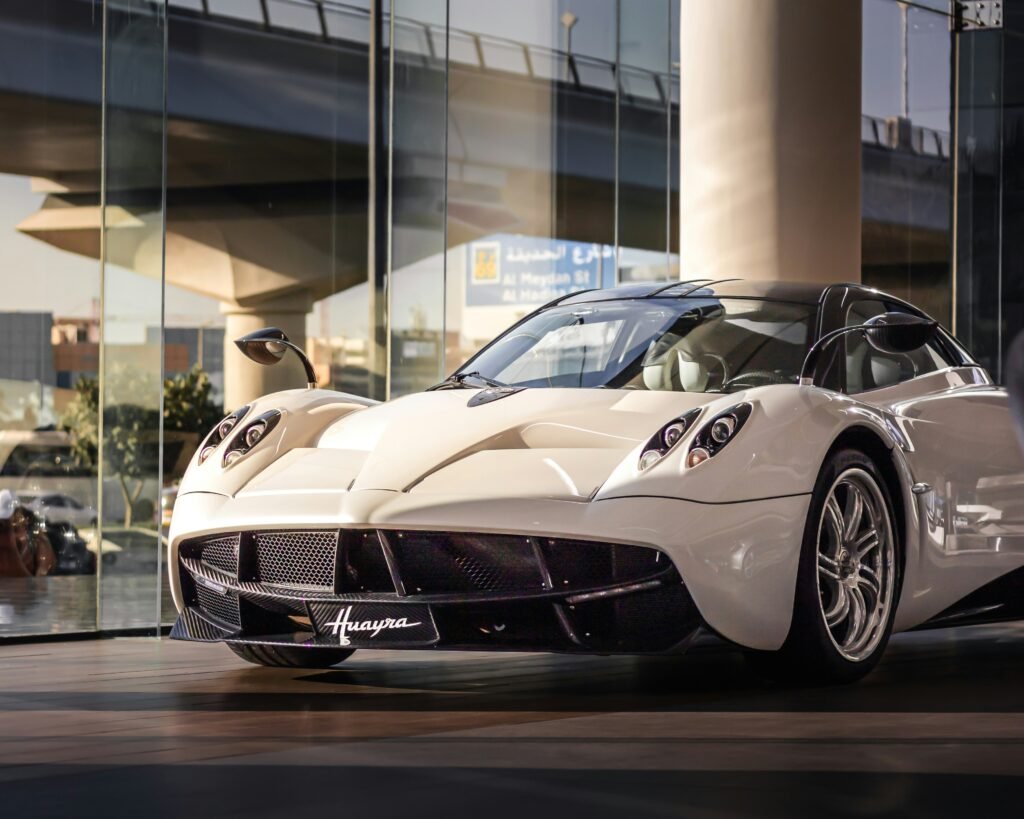
Those four movable flaps? They’re not just for show. The car constantly tweaks its own aerodynamics, almost like it’s alive, while those gull-wing doors and that dramatic diffuser make sure nobody mistakes it for anything else.
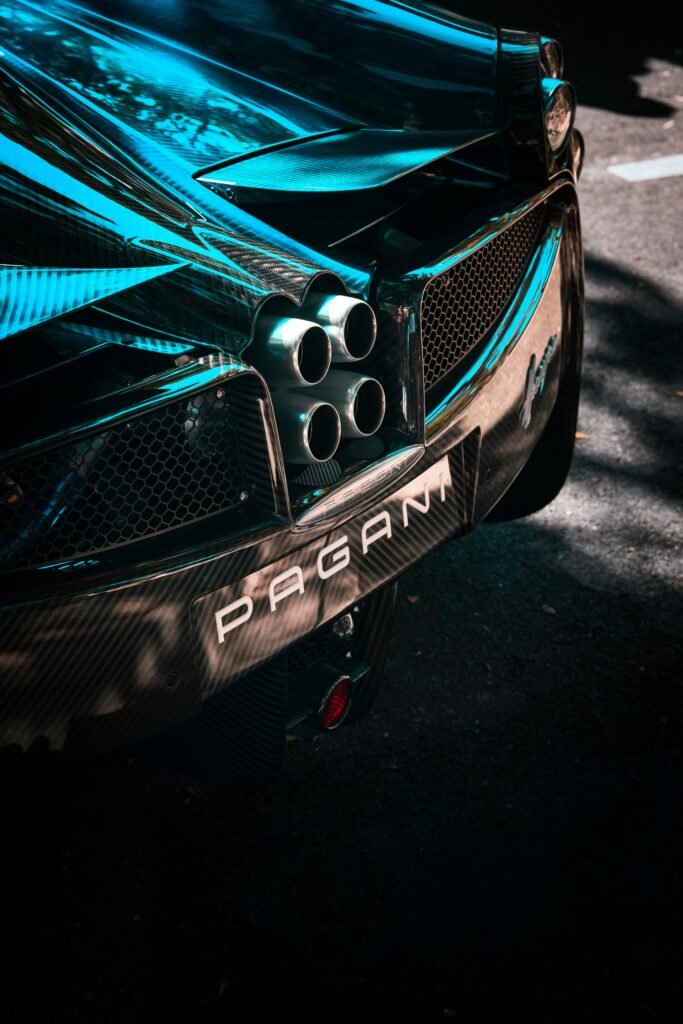
Carbon Fiber Monocoque and Carbotanium
The Huayra’s chassis relies on Carbo-Titanium, which is this mind-bending blend of carbon fiber and titanium. It’s like the best of both worlds—ultra-strong, yet light enough for a dancer.
This stuff gives the car a backbone that’s rigid and confidence-inspiring, clocking in at just 2,685 lbs total. Pagani’s construction methods keep things tight and responsive.
Because of Carbo-Titanium’s flexibility, the body panels curve and swoop in ways that old-school materials just can’t handle. Each panel gets hours of hand-finishing—seriously, it’s almost obsessive.
Key Material Benefits:
- Superior strength-to-weight ratio
- Enhanced crash protection
- Improved torsional rigidity
- Reduced manufacturing weight
Active Aerodynamics and Downforce
The Huayra’s active aerodynamics are a game-changer. Four flaps move around constantly, dialing in downforce and stability on the fly—no more fixed wings stuck in the past.
The flaps react to speed, steering, and even braking. They crank up the grip in corners, then cut drag when you’re blasting down a straight. It’s like the car’s reading your mind.
Front flaps channel air into the radiators and over the nose, while the rear ones handle airflow separation and rear grip. It’s all about balance, and honestly, it feels like magic.
Aerodynamic Performance:
- Front downforce: Variable based on speed
- Rear downforce: Adjustable through active flaps
- Drag reduction: Automatic optimization
- Stability enhancement: Real-time adjustments
Iconic Styling Elements: Gull-Wing Doors and Diffuser
Those gull-wing doors? They’re pure theater. But they’re also practical—ever tried to squeeze out of a supercar in a tight garage?
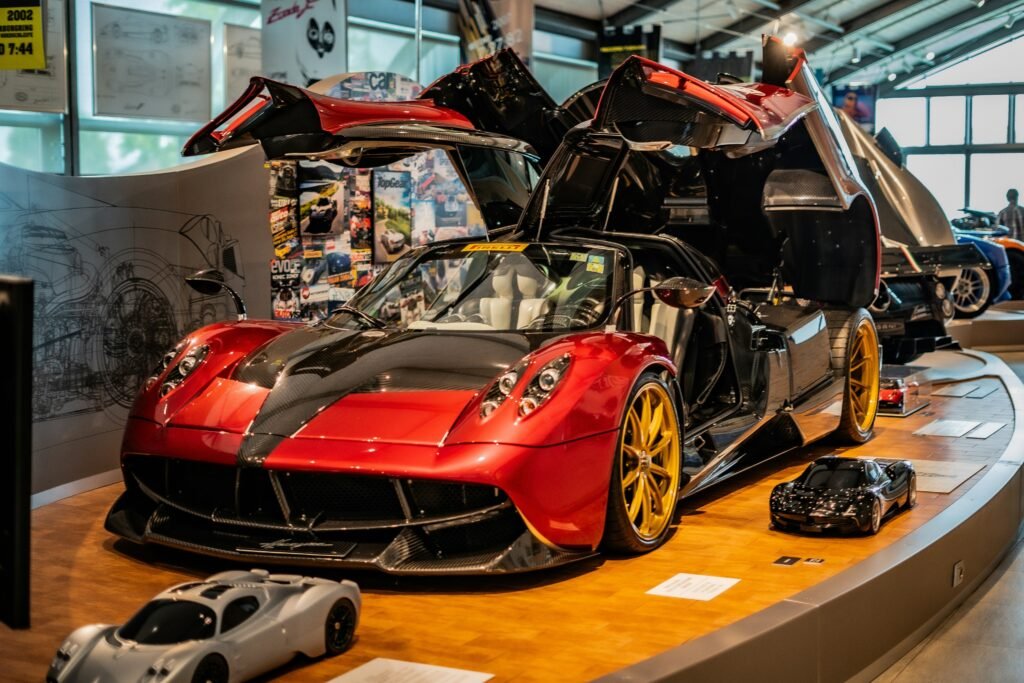
At about 44 pounds each, they’re surprisingly light for their size. Gas struts and clever safety tricks keep them from slamming down on you—thank goodness.
Out back, the diffuser stretches across the car, channeling air and squashing lift. It’s all about keeping the car glued to the road, even when you’re pushing the envelope.
Design Elements:
- Gull-wing doors: Upward-opening design
- Rear diffuser: Full-width aerodynamic element
- Side air intakes: Functional cooling ducts
- Exhaust outlets: Integrated into diffuser design and create one of the most beautiful sounds ever
Drag Coefficient Achievements
The Huayra slices through the air with a drag coefficient that’s almost laughably low. Wind-tunnel testing and those trick flaps let it hit 238 mph without breaking a sweat.
Pagani’s engineers obsessed over computational fluid dynamics. The car’s teardrop profile and carefully placed vents keep things slippery, but never at the expense of downforce.
Every vent and duct has a job—no wasted space, no fake vents. That’s how you get real speed.
Aerodynamic Specifications:
- Drag coefficient: Optimised for high-speed performance
- Downforce generation: Variable based on conditions
- Airflow management: Active system control
- Wind tunnel testing: Extensive development validation
Interior Craftsmanship and Infotainment
Step inside, and you’re hit with a mix of old-world luxury and modern tech. Everything’s hand-finished—no shortcuts, no corners cut. The cockpit feels like something out of a jet, with digital displays tucked into a sea of leather and metal.
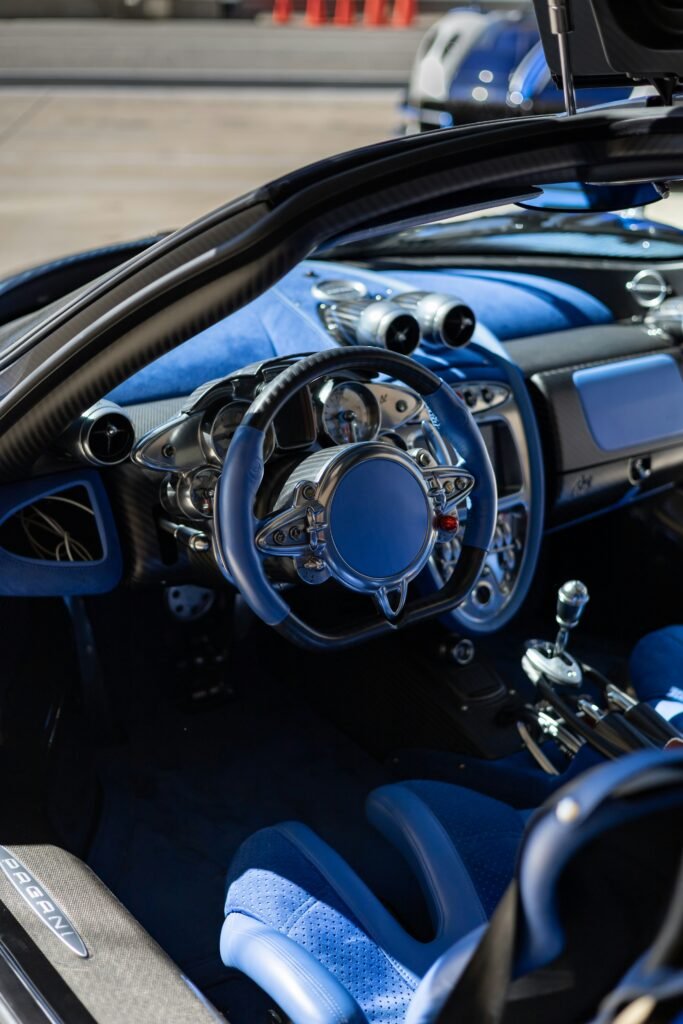
Hand-Stitched Leather Upholstery
Pagani’s artisans spend hours on those seats, hand-stitching leather with a precision that borders on neurotic. The patterns flow across the cabin like they’re drawn by an artist.
They source the leather from top-tier Italian suppliers, who treat each hide so it stays soft but tough—even if you drive like a maniac.
You can pick from nappa, semi-aniline, and a wild palette of colors. If you want purple with orange stitching, nobody’s stopping you.
Leather Quality Features:
- Premium Italian hides
- Hand-stitched construction
- Custom color options
- Contrast stitching available
The seats themselves? They look like futuristic saddles—Top Gear said so. They hug you tight when you’re cornering, but you won’t need a chiropractor after a long drive.
Infotainment and Driver-Focused Technology
The digital display system is all about giving you what you need, when you need it. You can tweak the layouts depending on your mood or driving mode.
The infotainment setup blends right in—navigation, music, car settings, it’s all there. Nothing feels tacked on or out of place.
Driver-assist features feed you info through the main screen, but never bombard you. The tech feels like a co-pilot, not a nagging backseat driver.
Touch controls are right where your hands fall. The system’s quick and doesn’t get washed out in sunlight—finally, someone gets it.
Artisan Detailing and Customization
Pagani’s team lavishes attention on every bit of trim. The mix of leather, metal, carbon fiber, and exposed mechanics feels almost steampunk, but somehow modern.
They weave and finish the carbon fiber by hand to match the exterior’s vibe. You’ll spot it everywhere, reminding you this thing is bred for speed.
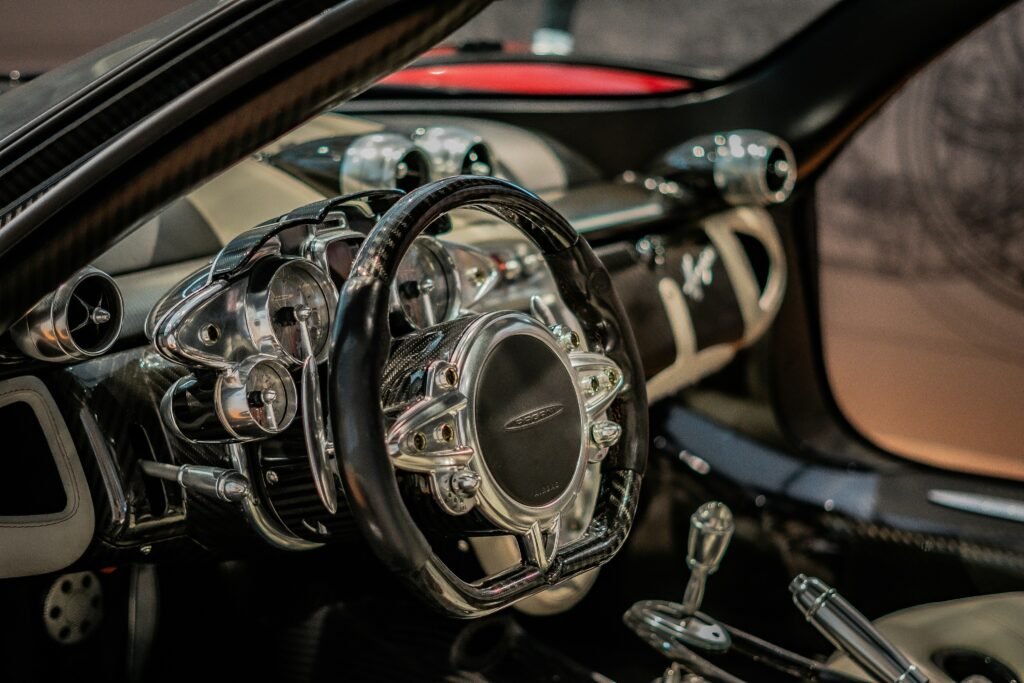
Metal bits get brushed, polished, or anodized—whatever works. It’s not just for looks; everything has a function.
Customization Options:
- Personalized embroidery
- Custom color combinations
- Unique trim materials
- Bespoke interior layouts
Every Huayra interior gets tailored to its owner. You want something nobody else has? Pagani’s happy to oblige.
Variants, Achievements, and Legacy
The Pagani Huayra has come a long way since 2011. Over the years, Pagani rolled out new versions that got lighter, faster, and even more exclusive.
Variants and Special Editions
First up, the Huayra BC—it dropped in 2016, packing 789 horsepower and shedding plenty of weight thanks to advanced carbon fiber. It’s basically the Huayra on a caffeine binge.
Then came the Huayra Roadster in 2017. You could pop the roof off and still get all the performance of the coupe, plus some extra style points.
Pagani didn’t stop there. The Huayra BC Roadster cranked everything up, mixing the BC’s rawness with open-air fun.
The Huayra R is the wildest of the bunch. It ditches street-legal stuff and goes full track monster, with a naturally aspirated V12 and even crazier aero.
All these versions stayed rare—the BC had just 20 units, and only 40 BC Roadsters exist. Blink and you’ll miss them.
Lap Records and Awards
The Huayra isn’t just a pretty face—it’s a beast on the track. It clocked some seriously quick lap times, proving it could hang with the best.
Even though Pagani didn’t publicly declare any Nürburgring Nordschleife lap times, it does have two other Lap records. 1st one is on theTop gear track and set a record of 1:13.8 seconds, which at that time made it the fastest-ever recorded lap Top gear track and the 2nd is at Good Woods with an incredible record of57.87 seconds
Key Performance Achievements:
- 0-60 mph in 2.8 seconds
- Top speed: 238 mph
- Active aero wizardry
- Super-lightweight build (2,685 lbs)
Car mags and industry folks showered it with praise. The mix of speed, artistry, and exclusivity turned heads everywhere, and this is evident when Top Gear named it “the Hypercar of the Year 2012”.
Pagani’s engineering chops really show in the Huayra’s active flaps and Carbo-Titanium. These aren’t just party tricks—they’re tech that changed the hypercar game.
Competitor Cars and Huayra’s Market Position
The Huayra rubs shoulders with the world’s wildest hypercars. Its main rivals? Think McLaren P1, Ferrari LaFerrari, and Koenigsegg’s finest—these are the unicorns of the car world.
Market Position:
- Ultra-limited production
- Hand-built, artisan approach
- Price tag north of $2 million
- Collector magnet
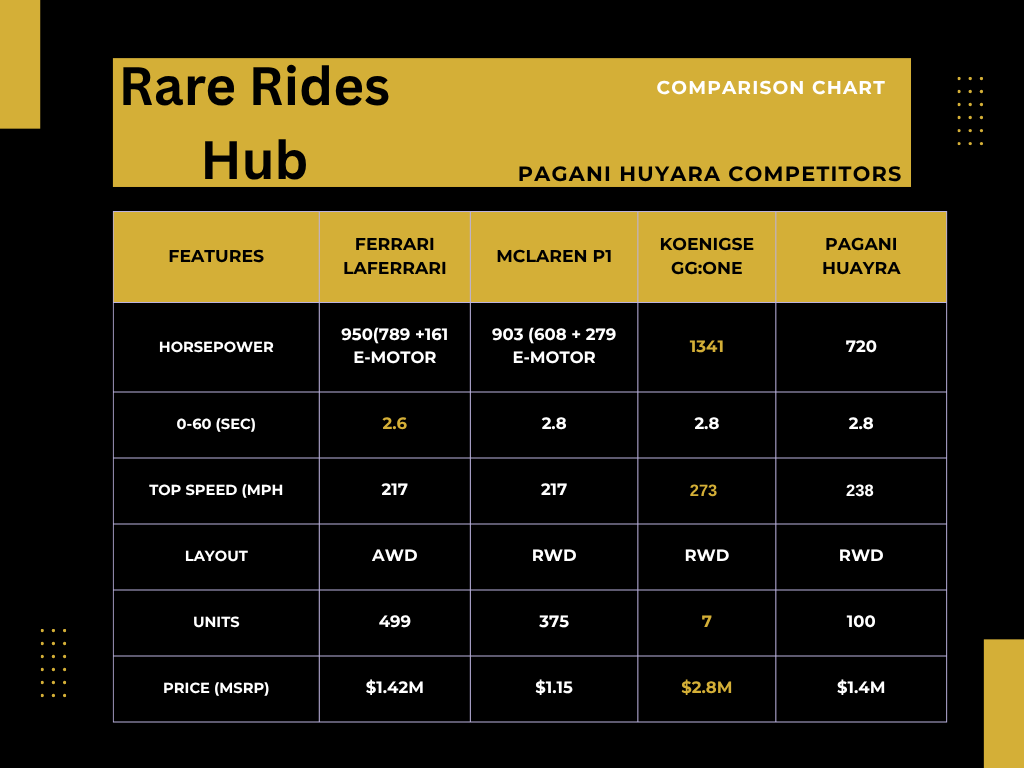
Here’s the thing: while the others chase tech for tech’s sake,Pagani leans hard into craftsmanship and personalization. It’s like the difference between a Swiss watch and a smartwatch—both impressive, but in totally different ways.
The Huayra’s active aero gives it a legit edge. It’s not just about numbers; it’s about how the car feels, how it responds, and how it makes you feel when you’re behind the wheel. And honestly, isn’t that what counts?
Price, Exclusivity, and Collector Value
The original Huayra hit the market with a jaw-dropping price tag—about $2.6 million. That instantly put it in the same league as the world’s most expensive production cars.
Special variants? Oh, those went for even more. Their rarity and beefed-up performance only drove the price higher.
Pricing Structure:
- Base Huayra MSRP $1.4 million
- BC variants: $3+ million
- Roadster models: $3.4+ million
- Custom options: Additional premium
Pagani built just 100 units of the original coupe. That’s not many—blink and you’ll miss your chance.
The Latest prices saw an increase in the Huayra’s value, with the latest being sold at an auction for around $1.9M and a Tempesta optional package for $2.42 M
They hand-assembled each car, and honestly, that alone slowed down production. You can’t really rush art, can you?
The Huayra’s value keeps climbing, and you can thank its collectible status for that. Pagani’s reputation and those low production numbers? They basically guarantee strong resale value in the wild world of secondary markets.
Collectors go wild for the Huayra’s blend of performance, craftsmanship, and sheer exclusivity. To them, it’s not just a hypercar—it’s a rolling piece of engineering art and, let’s be real, a pretty tempting investment too.
Final Words
Pagani, as a company, wasn’t created to just create fast cars, but most importantly, it was created to celebrate the great Italian craftsmanship that we barely see in other Italian companies like Ferrari and Lamborghini. Pagani, as a relatively new car company, has already created a name for itself among many competitors and not as a supercar company, but rather as an art first, speed second comapny.
Thanks for reading! If you enjoyed this deep dive, be sure to subscribe to my email list for exclusive car reviews, insider tips, and weekly special offers on car parts, auctions, and gear — perfect for any car enthusiast.
If you have any thoughts or experiences with this car? Leave a comment below — I love hearing your opinions and sparking conversations with fellow enthusiasts.
And don’t forget to read related posts for more great content!

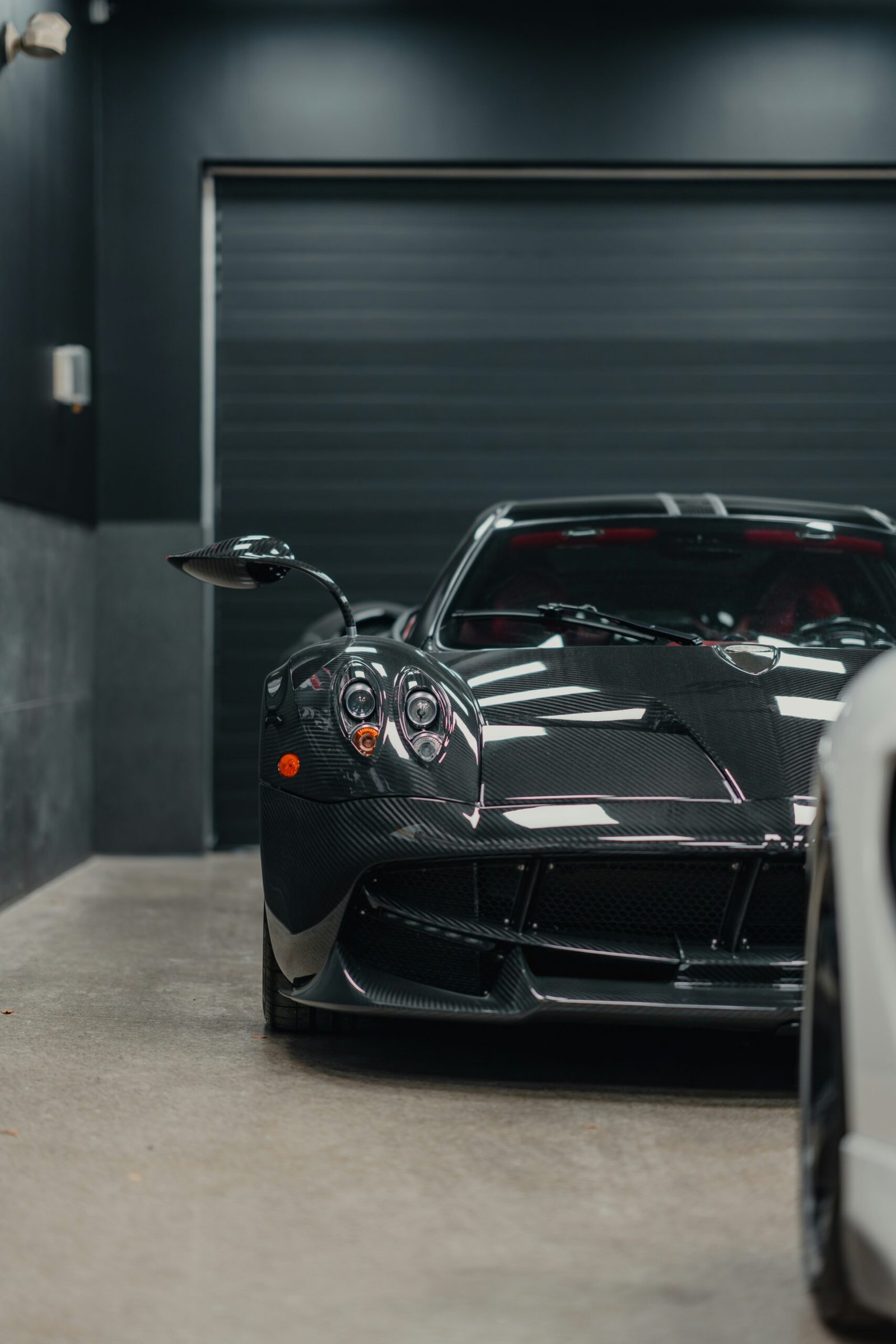
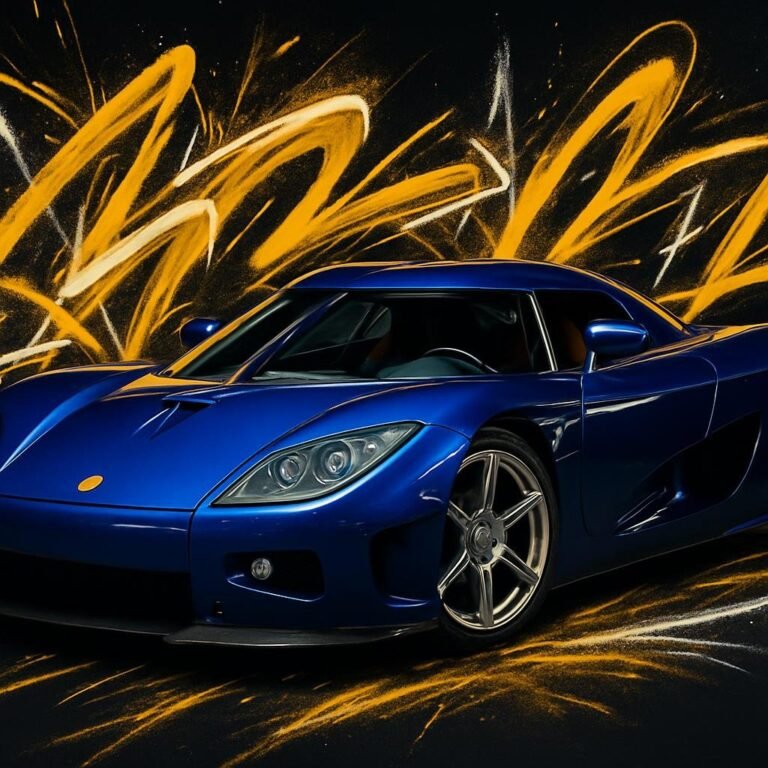
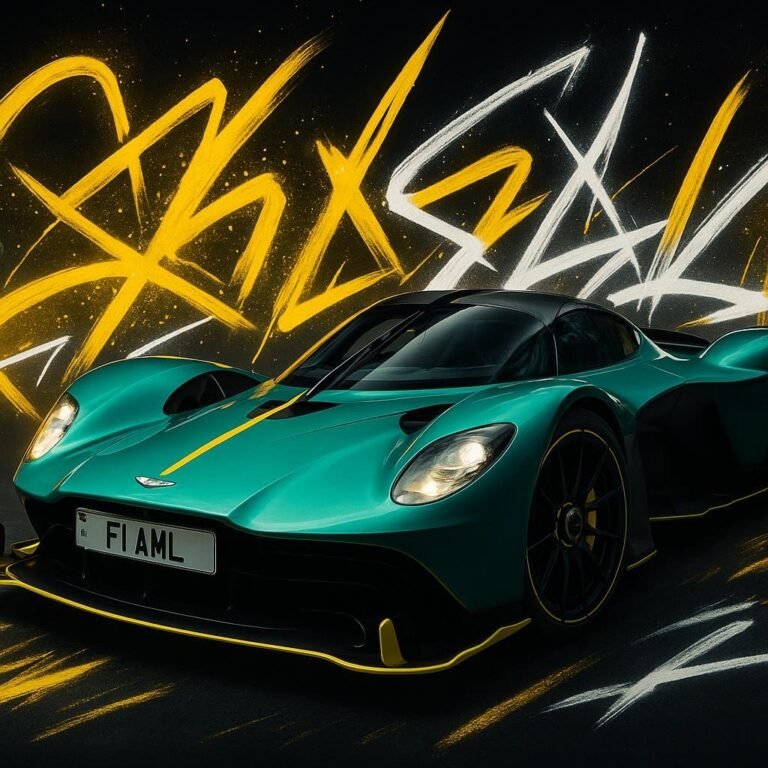
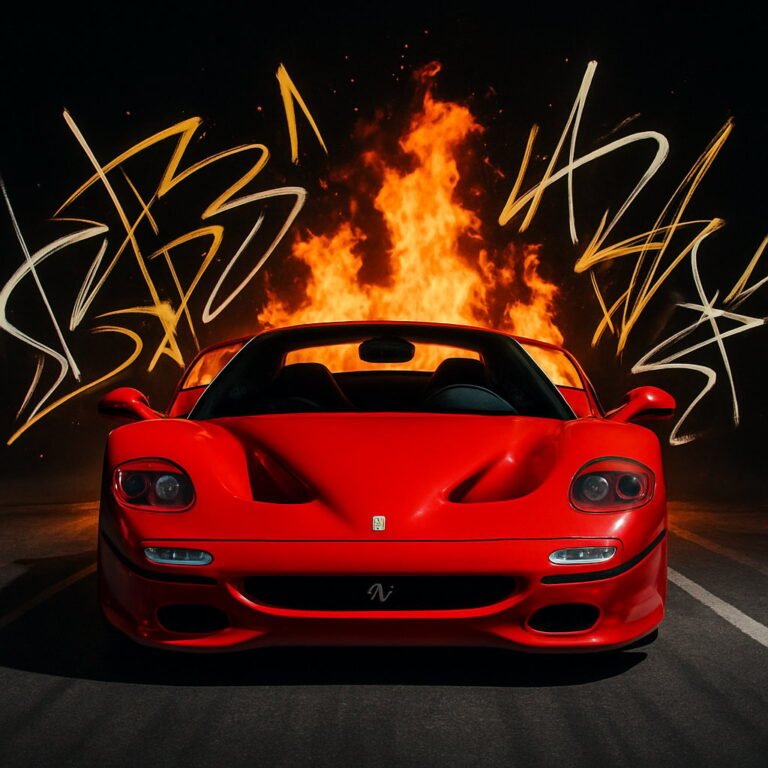
[…] isn’t just about looks—it’s a beast under the hood too. Mercedes went all out with a hand-built V12 engine and a transmission that makes every drive feel like a […]
[…] a splash at the Geneva Motor Show in March 2010. This wasn’t just another Zonda—it was the ultimate roadster in the […]